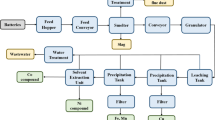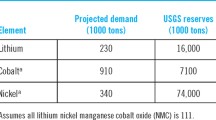Abstract
Lithium-ion batteries (LIBs) pose a significant threat to the environment due to hazardous heavy metals in large percentages. That is why a great deal of attention has been paid to recycling of LIBs to protect the environment and conserve the resources. India is the world's second-most populated country, with 1.37 billion inhabitants in 2019, and is anticipated to grow by 273 million people by 2050, according to the United Nations. The biggest obstacles for India's sustainable development will be reducing \({CO}_{2}\) emissions and satisfying the energy requirements of such densely populated country. The electric vehicle (EV) and renewable energy sectors have benefited as a result of this. Indian government wants to achieve 100 percent electric transportation by 2030, and the country's EV battery market is estimated to expand by $300 billion between 2017 and 2030. Batteries, on the other hand, are linked to a slew of difficulties, including their disposal as municipal solid hazardous waste at the end of their useful lives. Waste batteries, when properly utilised, can create several beneficial economic opportunities as well as jobs. This paper highlights India's lithium-ion battery market current scenario, potential, opportunities and various challenges associated with recycling procedures. The study of foreign market regulatory structures on recycling and management of lithium-ion battery waste is also being done, and few regulatory guidelines are being suggested that would improve the Indian battery recycling industry.




Source: Bloomberg New Energy Finance (BNEF)


Source: Bloomberg NEF



Similar content being viewed by others
Data Availability
Data sharing not applicable to this article as no datasets were generated or analysed during the current study.
References
Swain, B. (2017). Recovery and recycling of lithium: A review. Separation and Purification Technology, 172, 388–403.
〈http://batteryuniversity.com/learn/article/types_of_lithium_ion〉
Lv, W., Wang, Z., Cao, H., Sun, Y., Zhang, Y., & Sun, Z. (2018). A critical review and analysis of the recycling of spent lithium-ion batteries. ACS Sustainable Chemistry & Engineering, 6(2), 1504–1521.
Ordoñez, J., Gago, E. J., & Girard, A. (2016). Processes and technologies for the recycling and recovery of spent lithium-ion batteries. Renewable and Sustainable Energy Reviews, 60, 195–205.
Zheng, X., Zhu, Z., Lin, X., Zhang, Y., He, Y., Cao, H., & Sun, Z. (2018). A mini-review on metal recycling from spent lithium ion batteries. Engineering, 4(3), 361–370.
Martin, G., Rentsch, L., Höck, M., & Bertau, M. (2017). Lithium market research–global supply, future demand and price development. Energy Storage Materials, 6, 171–179.
Deshwal, D., Sangwan, P., & Dahiya, N. (2021). How will COVID-19 impact renewable energy in India? Exploring challenges, lessons and emerging opportunities. Energy Research & Social Science, 77, 102097.
Hill, M. K. (2020). Understanding environmental pollution. Cambridge University Press.
Yun, L., Linh, D., Shui, L., Peng, X., Garg, A., & LE, M.L.P., Asghari, S. and Sandoval, J.,. (2018). Metallurgical and mechanical methods for recycling of lithium-ion battery pack for electric vehicles. Resources, Conservation and Recycling, 136, 198–208.
Liu, C., Lin, J., Cao, H., Zhang, Y., & Sun, Z. (2019). Recycling of spent lithium-ion batteries in view of lithium recovery: A critical review. Journal of Cleaner Production., 228, 801–813.
Velázquez-Martínez, O., Valio, J., Santasalo-Aarnio, A., Reuter, M., & Serna-Guerrero, R. (2019). A critical review of lithium-ion battery recycling processes from a circular economy perspective. Batteries, 5(4), 68.
Wang, X., Gaustad, G., Babbitt, C. W., & Richa, K. (2014). Economies of scale for future lithium-ion battery recycling infrastructure. Resources, Conservation and Recycling, 83, 53–62.
King, S., & Boxall, N. J. (2019). Lithium battery recycling in Australia: Defining the status and identifying opportunities for the development of a new industry. Journal of Cleaner Production, 215, 1279–1287.
Steward, D., Mayyas, A., & Mann, M. (2019). Economics and challenges of Li-ion battery recycling from end-of-life vehicles. Procedia Manufacturing, 33, 272–279.
Placke, T., Kloepsch, R., Dühnen, S., & Winter, M. (2017). Lithium ion, lithium metal, and alternative rechargeable battery technologies: The odyssey for high energy density. Journal of Solid-State Electrochemistry, 21(7), 1939–1964.
Wentker, M., Greenwood, M., & Leker, J. (2019). A bottom-up approach to lithium-ion battery cost modeling with a focus on cathode active materials. Energies, 12(3), 504.
A report on India roadmap has electric vehicle value-chain in its sights by Global Data Energy.(https://www.power-technology.com/comment/electric-vehicles-in-india-2019)
Olivetti, E. A., Ceder, G., Gaustad, G. G., & Fu, X. (2017). Lithium-ion battery supply chain considerations: Analysis of potential bottlenecks in critical metals. Joule, 1(2), 229–243.
A report on Panasonic may set up li-ion battery module assembly unit in India. (https://www.livemint.com/companies/news/panasonic-may-set-up-lithium-ion-battery-module-assembly-unit-in-india-1565895588828.html)
Melin, H.E., 2018. The Lithium-Ion Battery End-of-Life Market—A Baseline Study. In World Economic Forum: Cologny, Switzerland (pp. 1–11).
Ellingsen, L. A. W., Hung, C. R., & Strømman, A. H. (2017). Identifying key assumptions and differences in life cycle assessment studies of lithium-ion traction batteries with focus on greenhouse gas emissions. Transportation Research Part D: Transport and Environment, 55, 82–90.
Zubi, G., Dufo-López, R., Carvalho, M., & Pasaoglu, G. (2018). The lithium-ion battery: State of the art and future perspectives. Renewable and Sustainable Energy Reviews, 89, 292–308.
Report on “Electrifying India: building blocks for a sustainable EV ecosystem”, May 2018
Gratz, E., Sa, Q., Apelian, D., & Wang, Y. (2014). A closed loop process for recycling spent lithium ion batteries. Journal of Power Sources, 262, 255–262.
Pagliaro, M., & Meneguzzo, F. (2019). Lithium battery reusing and recycling: A circular economy insight. Heliyon, 5(6), e01866.
Ramoni, M. O., & Zhang, H. C. (2013). End-of-life (EOL) issues and options for electric vehicle batteries. Clean Technologies and Environmental Policy, 15(6), 881–891.
Report on the implementation of EU waste legislation, including the early warning report for the Member States at risk of missing the 2020 preparation for reuse/recycling target on municipal waste.
Status Review Report on Implementation of Batteries (Management and Handling) Rules, 2001 (as amended thereof) - Report published by CENTRAL POLLUTION CONTROL BOARD in 2016.
Joshi, R., & Ahmed, S. (2016). Status and challenges of municipal solid waste management in India: A review. Cogent Environmental Science, 2(1), 1139434.
Report on “LITHIUM-ION BATTERY RECYCLING IN INDIA- Opportunities and challenges” by Agnes Richard, July 2019.
Sun, S. I., Chipperfield, A. J., Kiaee, M., & Wills, R. G. (2018). Effects of market dynamics on the time-evolving price of second-life electric vehicle batteries. Journal of Energy Storage, 19, 41–51.
Author information
Authors and Affiliations
Corresponding author
Ethics declarations
Conflict of interest
No conflict of interest in authors.
Additional information
Publisher's Note
Springer Nature remains neutral with regard to jurisdictional claims in published maps and institutional affiliations.
Rights and permissions
About this article
Cite this article
Deshwal, D., Sangwan, P. & Dahiya, N. Economic Analysis of Lithium Ion Battery Recycling in India. Wireless Pers Commun 124, 3263–3286 (2022). https://doi.org/10.1007/s11277-022-09512-5
Accepted:
Published:
Issue Date:
DOI: https://doi.org/10.1007/s11277-022-09512-5




